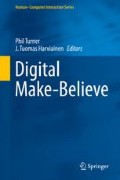Abstract
The acts of pretending and make-believe are almost exclusively studied in the context of child development and child psychology. This study was therefore an exploratory investigation of these functions in adulthood. Ten Foley artists were interviewed about the role of pretending and make-believe in their occupation, and the results supported our prediction that adults are capable of, and readily partake in, pretending and make-believe. We discuss the existing literature on pretending and make-believe, the methodological challenges we faced, and our conclusions based on extended quotes from the participants. It is hoped that our identification of ‘professional make-believers’ can instigate further research, and the study of pretending beyond childhood.
Access this chapter
Tax calculation will be finalised at checkout
Purchases are for personal use only
References
Clark A (2008) Supersizing the mind. Oxford University Press, Oxford
Cook A (2007) Interplay: the method and potential of a cognitive scientific approach to theatre. Theatr J 59:579–594
Cosmides L, Tooby J (2000) Consider the source: the evolution of adaptations for decoupling and metarepresentation. In: Sperber D (ed) Metarepresentations: a multidisciplinary perspective. Oxford University Press, Oxford
Dalton N, MacKay G, Holland S (2012) Kolab: appropriation & improvisation in mobile tangible collaborative interaction. DIS 2012, June 11–15, 2012, Newcastle, UK, pp 21–24
Garvey C (1990) Play. Harvard University Press, Cambridge
Goldstein TR, Bloom P (2011) The mind on stage: why cognitive scientists should study acting. Trends Cogn Sci 15(4):141–142
Harris P (2000) The work of the imagination. Blackwell, London
Jent JF, Niec LN, Baker SE (2011) Play and interpersonal processes. In: Russ SW, Niec LN (eds) Play in clinical practice: evidence-based approaches. Guilford Press, New York
Leslie AM (1987) Pretense and representation: the origins of “theory of mind”. Psychol Rev 94:412–426
Lillard AS (2001) Pretend play as twin earth: a social cognitive analysis. Dev Rev 21:495–531
McGonigal J (2011) Reality is broken. Jonathan Cape, London
Miles MB, Huberman AM, Saldana J (2014) Qualitative data analysis: a methods sourcebook. Sage Publications Inc., California
Nakayama H (2013) Changes in the affect of infants before and after episodes of crying. Infant Behav Dev 36(4):507–512
Nichols S, Stich S (2005) Mindreading: a cognitive theory of pretense. Oxford University Press, Oxford
Pollio HR, Henley TB, Thompson CJ (1997) The phenomenology of everyday life. Cambridge University Press, Cambridge
Prinz W (1984) Modes of linkage between perception and action. In: Prinz W, Sanders A-F (eds) Cognition and motor processes. Springer, Berlin, pp 185–193
Russ SW (2004) Play in child development and psychotherapy. Erlbaum, Mahwah
Rutherford MD, Young GS, Hepburn S, Rogers SJ (2007) A longitudinal study of pretend play in autism. J Autism Dev Disord 37(6):1024–1039
Seja AL, Russ SW (1999) Children’s fantasy play and emotional understanding. J Clin Child Psychol 28:269–277
Turner P, Hetherington R, Turner S, Kosek M (2015) The limits of make-believe. Digital Creativity
Vygotsky LS (1930) The instrumental method in psychology. Available from https://www.marxists.org/archive/vygotsky/works/1930/instrumental.htm. Last retrieved 3 July 2015
Walton KL (1990) Mimesis as make-believe: on the foundations of the representational arts. Harvard University Press, Cambridge
Walton KL (1993) Metaphor and prop oriented make-believe. Eur J Philos 1(1):39–57
Acknowledgements
Considering how busy the artists are, and the small time frames they have to complete projects, we were delighted and very grateful that they enthusiastically took time out of their schedules to speak to us. Thank you to Julie Ankerson, Céline Bernard, Ronni Brown, Mauricio Castañeda, Richard Hinton, Carlos de la Madrid Valencia, Maureen Murphy, John Simpson, Barnaby Smyth, and Lise Wedlock.
We recognise and are grateful for the financial support from Edinburgh Napier University for a summer internship. Thanks also to Iain McGregor for his technical support.
Author information
Authors and Affiliations
Corresponding author
Editor information
Editors and Affiliations
Rights and permissions
Copyright information
© 2016 Springer International Publishing Switzerland
About this chapter
Cite this chapter
Carruthers, L., Turner, P. (2016). The Role of Make-Believe in Foley. In: Turner, P., Harviainen, J. (eds) Digital Make-Believe. Human–Computer Interaction Series. Springer, Cham. https://doi.org/10.1007/978-3-319-29553-4_8
Download citation
DOI: https://doi.org/10.1007/978-3-319-29553-4_8
Published:
Publisher Name: Springer, Cham
Print ISBN: 978-3-319-29551-0
Online ISBN: 978-3-319-29553-4
eBook Packages: Computer ScienceComputer Science (R0)

